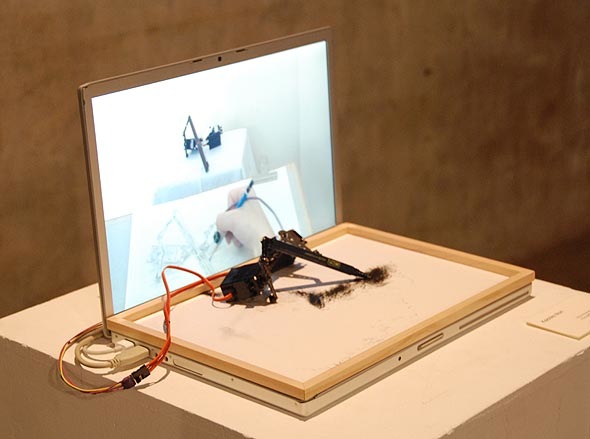blog
ARTSAT Internet Radio (3) added
- 2011-05-25-artsat-internet-radio-3-added
projectに ARTSAT Internet Radioを追加しました。 ラジオ絶賛放送中
ARTSAT Internet Radio
- 2011-05-23-artsat-internet-radio
generative net radio 2011

I put up the Internet radio streaming that named "ARTSAT Internet Radio" which uses data from sensors of the super-small satellite. It's using SuperCollider3 Server and generating sounds with data from the satellite and controls parameters.
listening point's URL:
gs.idd.tamabi.ac.jp:8100/listen.m3u
At Nakasuka Laboratory in The University of Tokyo, the super-small satellite "PRISM" was launched in 2008 and now over our head."PRISM" has several kinds of sensors and sends telemetry data from height of 660km.
http://www.space.t.u-tokyo.ac.jp/prism
There are four times data transmissions par a day with the satellite at Ground Station,and update data to the website.In the streaming server, scripts are running and analyzing this website(this part is with Python) and write a XML file,Then SuperCollider reads this XML file intermittently and map parameters to Synths.
We proceed projects to try how we utilize the satellite for artistic purposes {its name is "ARTSAT Project") So it's not only for musical expressions but also for others. This Internet radio is a part of this projects.
In this radio streaming, I want to investigate new method of composition of "orbital music"..
Quantum Composition
- 2011-04-23-quantum-composition
live performanse 2010
After research with Tsubasa Tanaka a pianist and a science researcher about relation between "Schroedinger equation" and context for musical composition, we produced the audio visual performance that was integrated piano playing with multi channel audio. Tsubasa says that the state of Quantum superposition looks like a correlation between composition's theme and variations. Composers create variations from one theme. But they are non-observed at that time, then they manifest themselves when we perceive as a sound and vibration or a score. So Is it possible that to be perceive variations as "superposition" we thought. In that performance we played Goldberg Variations by J. S. Bach with variations which added effects calculated from Schroedinger equation in realtime.
Above video is version of digital solo performance. It could control from mouse input to make obstacles to control wavefunction which used as parameters for sound effects. This is made with openframeworks and SuperCollider 3.


Gillette/An Altar
- 2011-04-23-gillettean-altar
installation 2009

“Gillette/An Altar” is an installation work with the machine that draws his own portrait with servo motors and a pen. It sketches first of all with the pencil by which the person installed the sensor, movement is extracted, and it records. The machine drives the servo motor with the record image based on data, and does the drawing. The subject described by the thing with a mirror of image prints from person’s hand to the machine and it replaces it. The frame obscures which hither and there the painter is. The subject drawing always does the slide between frames. This is a “Between Painting” that used mirror and frame.

「ジレット/祭壇」はサーボモーターとペンを使って自画像を描くマシンによるインスタレーション作品。まず人がセンサーを取り付けた鉛筆でデッサンをして、動きを抽出し記録する。マシンはデータを元にその記録映像と共にサーボモーターを駆動し、ドローイングをしてゆく。映像という鏡を用いる事で描写をする主体が人の手からマシンへとすり替わっている。フレームは画家が、こちら側とあちら側、どちらにいるのかを曖昧にしている。描く主体はフレームの間を絶えずスライドしている。鏡とフレームを用いたビトウィーン絵画作品。


